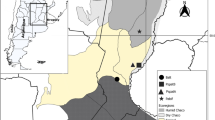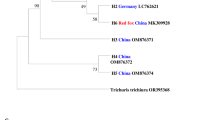Abstract
Background
Fleas belonging to the Pulicidae are prevalent ectoparasites infesting mammals and birds in Iran. This study focused on genetically identifying and characterizing Ctenocephalides canis collected both off-host and infesting humans and various domestic animals in the country.
Methods
A total of 918 adult flea samples were collected from 10 sites in western and northwestern Iran between April 2018 and May 2019. Out of these, 71 specimens were found off-host, while the remaining fleas were collected from humans (121), sheep (126), goats (184), and dogs (416). Morphological identification at the genus level was performed on all fleas, and ten selected specimens selected based on the sampling sites and hosts were subjected to molecular detection at the species level by using partial amplification and sequencing of the internal transcribed spacer 1 and 2, as well as the cytochrome oxidase I (COXI) markers.
Results
The morphological identification confirmed all fleas as Ctenocephalides spp. Alignment and phylogenetic analysis of nuclear and mitochondrial partial sequences confirmed the presence of C. canis. However, molecular divergence was observed among the ten isolates based on the ITS1 and ITS2 with diversity rates estimated at 0.15% and 3.36%, respectively. Notably, the analysis of the COXI marker revealed no molecular divergence among the partial sequences representing the ten studied isolates from C. canis.
Conclusions
This study explores the diversity of C. canis in the western and northwestern regions of Iran, providing insights into their molecular taxonomy and potential role as disease vectors in these areas.








Similar content being viewed by others
Data Availability
The data that support the findings of this study are available from the corresponding author upon reasonable request.
References
Sidhoum NR, Boucheikhchoukh M, Mechouk N, Deak G (2023) An overview of fleas (Siphonaptera) in wild and domestic mammals from Algeria with new data from the central north and south of the country. Acta Trop 247:107004. https://doi.org/10.1016/j.actatropica.2023.107004
Lewis RE (1998) Resume of the Siphonaptera (Insecta) of the World. J Med Entomol 35:377–389
Sanjuán CG, Aguirre JI, Villaverde S, Banda E, Hernandez SM, Yabsley MJ (2022) Surveillance for gastrointestinal, subcutaneous, and ectoparasites of invasive north American raccoons (Procyon lotor) in central Spain. Vet Parasitol Reg Stud Rep 36:100793. https://doi.org/10.1016/j.vprsr.2022.100793
Shipstone MA, Mason KV (1995) The Use of Insect Development inhibitors as an oral medication for the control of the fleas ctenocephalides felis, Ct. canis in the dog and cat. Vet Dermatol 6:131–137. https://doi.org/10.1111/j.1365-3164.1995.tb00056.x
Marshall AG (1981) The ecology of ectoparasitic insects. Academic Press Inc (London) Ltd
Dobler G, Pfeffer M (2011) Fleas as parasites of the family Canidae. Parasit Vectors 4:1–2
Akhtardanesh B, Khedri J, Tokasi M, Tazerji SS, Shokrollahi N, Sadeghi B, Poursina M, Malik YS, Hajipour P (2023) Survey of Common Infectious diseases in Urban foxes in Southeastern Iran. J Wildl Dis. https://doi.org/10.7589/JWD-D-23-00028. 10.7589/JWD-D-23-00028. Advance online publication
Beugnet F, Marie JL (2009) Emerging arthropod-borne diseases of companion animals in Europe. Vet Parasitol 163:298–305
Lappin MR, Hawley J (2009) Presence of Bartonella species and Rickettsia species DNA in the blood, oral cavity, skin and claw beds of cats in the United States. Vet Dermatol 20:509–514
Minahan NT, Wu WJ, Tsai KH (2023) Rickettsia felis is an emerging human pathogen associated with cat fleas: a review of findings in Taiwan. J Microbiol Immunol Infect 56:10–19. https://doi.org/10.1016/j.jmii.2022.12.006
Azarm A, Dalimi A, Mohebali M, Mohammadiha A, Zarei Z (2016) Morphological and molecular characterization of Ctenocephalides spp. isolated from dogs in north of Iran. J Entomol Zoolog Stud 4:713–717
Gamerschlag S, Mehlhorn H, Heukelbach J, Feldmeier H, D’Haese J (2008) Repetitive sequences in the ITS1 region of the ribosomal DNA of Tunga penetrans and other flea species (Insecta, Siphonaptera). Parasitol Res 102:193–199
Vobis M, D’Haese J, Mehlhorn H, Mencke N, Blagburn BL, Bond R, Denholm I, Dryden MW, Payne P, Rust MK, Schroeder I, Vaughn MB (2004) Molecular phylogeny of isolates of Ctenocephalides felis and related species based on analysis of ITS1, ITS2 and mitochondrial 16S rDNA sequences and random binding primers. Parasitol Res 94:219–226
Zurita A, Callejon R, Garcia-sanchez AM, Urdapilleta M, Lareschi M, Cutillas C (2019) Origin, evolution, phylogeny and taxonomy of Pulex irritans. Med Vet Entomol 33:296–311
Bowen BW, Clark AM, Abreu-Grobois FA, Chaves A, Reichart HA, Ferl RJ (1997) Global phylogeography of the Ridley sea turtles (Lepidochelys spp.) as inferred from mitochondrial DNA sequences. Genetica 101:179–189
Guo L, Gao F, Cheng Y, Gao C, Chen J, Li Z, Wang T, Xu J (2020) Mitochondrial COI sequence variations within and among Geographic samples of the Hemp Pest Psylliodes attenuata from China. Insects 11:370. https://doi.org/10.3390/insects11060370
Simon C, Frati F, Beckenbach A, Crespi B, Liu H, Flook P (1994) Evolution, weighting, and phylogenetic utility of mitochondrial gene sequences and a compilation of conserved polymerase chain reaction primers. Ann Entomol Soc Am 87:651–701
Skerman KO, Shahlapoor A, Eslami A, Eliazian M (1970) Observations on the incidence, epidemiology, control and economic importance of gastrointestinal parasites of sheep and goat in Iran. Arch Razi Inst 22:187–196
Asmar M, Piazak N, Karimi Y (1979) An illustrated key for fleas of Iran. Pasteur Inst Iran 2–15
Shayan A, Rafinejad J (2006) Arthropod parasites of rodents in Khorram Abbad district, Lorestan Provincen of Iran. Iran J Public Health 35:70–76
Lawrence AL, Webb CE, Clark NJ, Halajian A, Mihalca AD, Miret J, D’Amico G, Brown G, Kumsa B, Modrý D, Šlapeta J (2019) Out-of-Africa, human-mediated dispersal of the common cat flea, Ctenocephalides felis: the hitchhiker’s guide to world domination. Int J Parasitol 49:321–336
Lawrence AL, Hii SF, Jirsova D, Panakova L, Mlonica A, Gilchrist K, Modry D, Mihalca AD, Webb CE, Traub RJ (2015) Integrated morphological and molecular identification of cat fleas (ctenocephalides felis) and dog fleas (ctenocephalides canis) vectoring Rickettsia felis in central Europe. Vet Parasitol 10:215–223
Folmer O, Black M, Hoeh W, Lutz R, Vrijenhoeket R (1994) DNA primers for amplification of mitochondrial cytochrome c oxidase subunit I from diverse metazoan invertebrates. Mol Mar Biolog Biotechnol 3:294–299
Lv J, Wu S, Zhang Y, Chen Y, Feng C, Yuan X, Jia G, Deng J, Wang C, Wang Q, Mei L, Lin X (2014) Assessment of four DNA fragments (COI, 16S rDNA, ITS2, 12S rDNA) for species identification of the Ixodida (Acari: Ixodida). Parasit Vectors 7:93
Bahrami S, Kharrati L, Makki M (2016) The First Case Report of Human Infestation with ctenocephalides canis in Behbahan (Khuzestan Province). J Ardabil Uni Med Sci 16:317–322
Tavassoli M, Ahmadi A, Imani A, Ahmadiara E, Javadi S, Hadian M (2010) Survey of flea infestation in dogs in different geographical regions of Iran. Korean J Parasitol 48:145–149
Yakhchali M, Bahramnejad K, Hosseine A (2015) Prevalence and ectoparasites fauna of sheep and goat flocks in Urmia suburb, Iran. Veterinarski Arhiv 76:431–442
Van der Mescht L, Matthee S, Matthee CA (2015) Comparative phylogeography between two generalist flea species reveal a complex interaction between parasite life history and host vicariance. Parasite-host association matters. BMC Evol Biol 15:1–5
Hornok S, Beck R, Farkas R, Grima A, Otranto D, Kontschan J, Takacs N, Horvath G, Szoke K, Szekeres S, Majoros G, Juhasz A, Salant H, Hofmann-Lehmann R, Stanko M, Baneth G (2018) High mitochondrial sequence divergence in synanthropic flea species (Insecta: Siphonaptera) from Europe and the Mediterranean. Parasit Vectors 11:221
Seyyedzadeh SJ, Bozorgomid F, Telmadarraiy Z, Terenius O, Chavshin AR (2018) Evidence for the presence of Ctenocephalides orientis in livestock dwellings in northwest Iran. Med Vet Entomol 32:383–387
Krasnov BR, Shenbrot G, Khokhlova IS (2015) Historical biogeography of fleas: the former BeringLand Bridge and phylogenetic dissimilarity between the Nearctic and Palearctic assemblages. Parasitol Res 114:1677–1686
Ilinsky Y, Lapshina V, Verzhutsky D, Fedorova Y, Medvedev S (2022) Genetic evidence of an isolation barrier between Flea subspecies of Citellophilus tesquorum (Wagner, 1898) (Siphonaptera: Ceratophyllidae). Insects 13:126. https://doi.org/10.3390/insects13020126
Marrugal A, Callejon R, de Rojas M, Halajian A, Cutillas C (2013) Morphological, biometrical and molecular characterization of Ctenocephalides felis and Ctenocephalides canis isolated from dogs from different geographical regions. Parasitol Res 112:2289–2298
Ghavami MB, Mirzadeh H, Mohammadi J, Fazaeli A (2018) Molecular survey of ITS1 spacer and Rickettsia infection in human flea. Pulex irritans Parasitol Res 117:1433–1442
Zurita A, Callejon R, de Rojas M, Halajian A, Cutillas C (2016) Ctenocephalides felis and ctenocephalides canis: introgressive hybridization? Syst Entomol 41:567–579
Acknowledgements
The authors would like to thank the members of the Faculty of Veterinary Medicine and Urmia University Research Council for the approval and financial support of this research. The authors claim that they have no disputes of interest.
Funding
The study was funded by Urmia University, Iran.
Author information
Authors and Affiliations
Contributions
SS conceptualized the study, supervised the project, and wrote the original draft. SS, MT and FMF conducted investigations, contributed to methodology, and performed formal analysis. MBS validated results, and edited and finalized the manuscript.
Corresponding authors
Ethics declarations
Ethical Approval
The ethical issues are not applicable to the article, due to no human and animals involvement.
Conflict of interest
The authors declare they have no conflicts of interests.
Additional information
Publisher’s Note
Springer Nature remains neutral with regard to jurisdictional claims in published maps and institutional affiliations.
Rights and permissions
Springer Nature or its licensor (e.g. a society or other partner) holds exclusive rights to this article under a publishing agreement with the author(s) or other rightsholder(s); author self-archiving of the accepted manuscript version of this article is solely governed by the terms of such publishing agreement and applicable law.
About this article
Cite this article
Seidi, S., Tavassoli, M., Malekifard, F. et al. Molecular Identification, Multigenic Characterization and Phylogenetic Analysis of Ctenocephalides Canis Fleas from Humans and Domestic Animals in Iran. Acta Parasit. (2024). https://doi.org/10.1007/s11686-024-00846-7
Received:
Accepted:
Published:
DOI: https://doi.org/10.1007/s11686-024-00846-7




